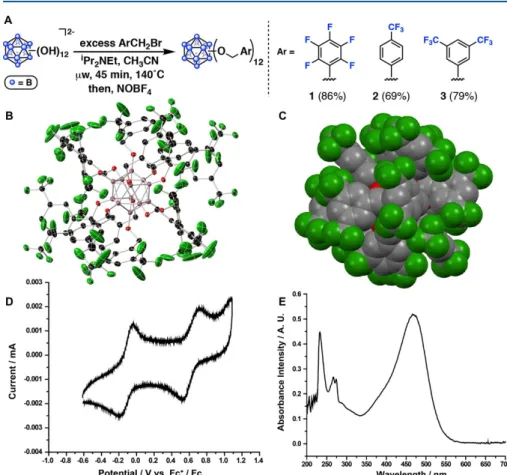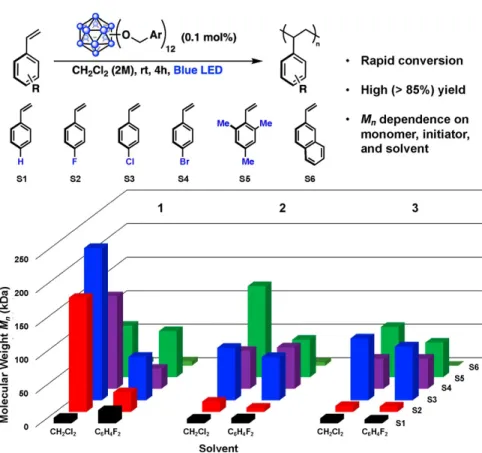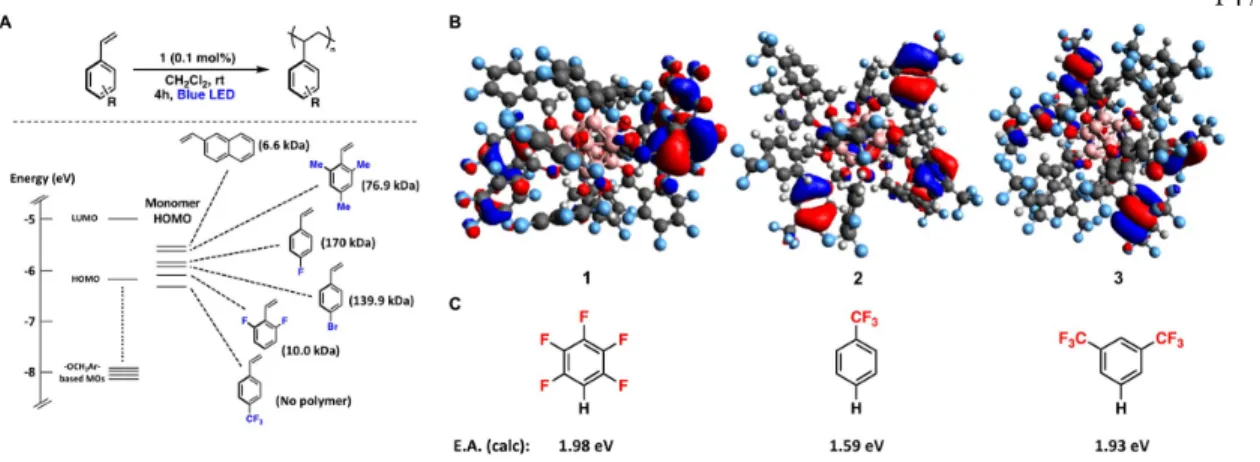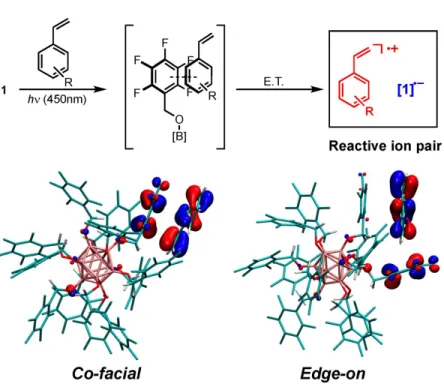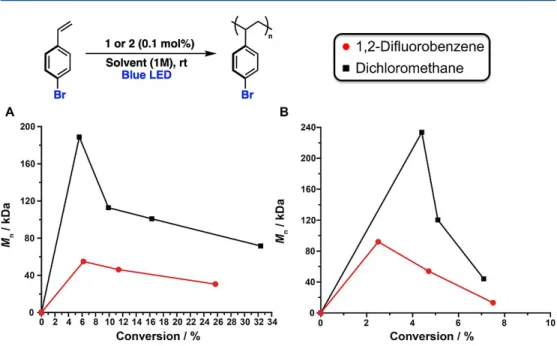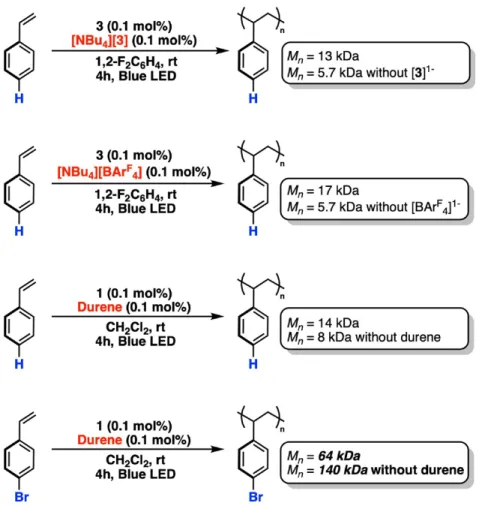In most cases, the polydispersities range from ~1.8 to 2.3 and appear to be independent of the trend observed for polymers generated using 1 and S2-S4 in CH2Cl2. Analysis of the polymer by matrix-assisted laser desorption ionization mass spectrometry showed no initiator incorporation in any case tested (see the Supporting Information (SI) for representative examples); this is consistent with previously obtained inductively coupled plasma mass spectrometry data11 as well as the overall inertness of the dodecaborate counterion in the presence of a reactive cationic chain end. We suggest that the unique distribution of polymer molecular weights based on solvent, initiator, and monomer indicates both the weak interaction behavior of the dodecaborate anions with the cationic chain end, and an easily influenced equilibrium (vide infra) of these interactions by contact ion pairs in more efficiently soluble ion pairs; the location of this equilibrium ultimately determines the resulting Mn values.
Attempts to probe the proposed intermolecular interactions of perfunctionalized dodecaboranes and a donor molecule (e.g., styrene) spectroscopically prior to ET have so far been unsuccessful, consistent with the short lifetime of the excited state (τ = ~ 311 ps for high). Excited-state reduction potential and group-based HOMO and LUMO levels of 1−3 in the ground state (see below). First, we investigated whether the generation of high Mn polymers from 1 resulted simply from the difference in energy between the HOMO of the monomer and the lower-energy, cluster-based donor orbital(s) responsible for light absorption blue. Additionally, the HOMO of the system is localized to styrene, again suggesting that ET from styrene upon photoexcitation of the cluster is mechanistically reasonable.
Interestingly, when modeling in CH3CN, both the HOMO and LUMO of the system are mostly located in the core of the cluster. The cofacial and edge dispositions of the styrene-based HOMO relative to the 1-based molecular orbital indicate possible hole transfer to the substrate. Although we were unable to experimentally identify either the preorganization of the substrate or the relative orientation of styrene and initiator, as shown in Fig. A.5, they represent plausible modes of interaction by which ET can occur.
Based on the solid-state crystal structure of 3 , the closest intermolecular B−C or O−C distances (analogous to the initiator−substrate distances) are within 15 Å.
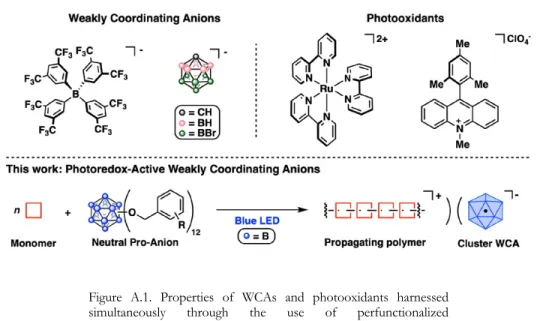
Discussion of Photoinitiated Polymerization Studies
Interestingly, gel permeation chromatography analysis of the same time points revealed that while the Mn values of poly-S1 and poly-S5 remained fairly consistent and low (~20 and ~50 kDa, respectively) during the course of polymerization, the Mn of poly-S4 began at ~190 kDa and gradually decreased during the time frame in which aliquots were taken. This suggests that the relationship between the rate of propagation and the rate of chain transfer for S4 is fundamentally different from that of S1 and S5, and that this relationship reaches a steady state much later in the polymerization. While we note that random water can act as a powerful chain transfer agent in carbocationic polymerizations, the clear dependence of Mn on the solvent and initiator suggests that the components of the reaction are more relevant to the observed polymer metrics.
The electron-withdrawing functional groups should make the β-proton of the propagating cationic chain more acidic than those in [poly-S1]+ or [poly-S5]+, making it increasingly susceptible to H+ loss. However, it is unclear why the Mn values for poly-S1 and poly-S5 also do not gradually decrease with time, but rather remain constant during the course of polymerization. We find that the conversion of S1 in the presence of 1 to CH2Cl2 is slower than that of 1,2-difluorobenzene.
This indicates that solvophobic effects similarly affect the polymerizations of S4 with 1, likely as a result of the ion-pairing strength of oligo- or poly-S4, in particular, with 1. To understand whether the similarity in propagation speed was a function of the combination of S4 and 1 or dependent on S4 alone, we performed a similar set of experiments with 2 and S4. Beyond solvophobic effects, it is also possible that 1,2-difluorobenzene materially interferes with ion pairing, particularly in the case of 1 and S2–S4 (see below).
Furthermore, Sherill and co-workers showed that dispersion interactions can contribute significantly to the strength of the arene-arene interactions in face-to-face and edge-on arrangements of aryl rings.37 The non-negligible effect of the solvent on intermolecular interactions has detailed,33b,38 often in the context of effects on the electrostatic interactions or analyte desolvation. Finally, Cockroft and co-workers also outlined the importance of substituent solvation in modulating the electrostatic potentials of aromatic systems.39 Although we cannot definitively identify the specific type of intermolecular interactions in the present case, based on our computational data of monomer interactions with 1 (see Figure A.5) and the high local density of aryl substituents in 1−3 (especially the -C6F5 rings in 1), electrostatic, dispersion, charge transfer, and solvophobic effects likely all contribute to the interactions of monomer with the ring periphery of the dodecaborate photoinitiators and is most prominent between S2 and S4 with 1 in CH2Cl2.40. Control polymerization experiments with [3]- were performed and found not to initiate S1 polymerization under standard conditions, suggesting that 3 is entirely responsible for the initial reactivity and oxidation of the styrene monomers.
In the carbocationic polymerization of styrene with SnCl4, Overman and Newton observed that the addition of either durene or hexamethylbenzene resulted in an increase in the Mn of the resulting polystyrene. We found that the addition of durene (1 equiv to 1) to the polymerization of S1 with 1 under standard conditions increased the molecular weight of the resulting polymer only slightly (average 14 vs. 8 kDa), but did not significantly change the yield of resulting polystyrene compared to the polymerization of styrene with 1 alone. In an analogous reaction, the durene (1 equiv relative to 1) was used as an additive in the polymerization of S4 with 1.
In this case, we found that Mn and Mw were halved compared to poly-S4 produced in the absence of durene, while the overall reaction yield was still comparable (Figure A.8). We must also consider the possibility that similar interferences occur in the 1,2-difluorobenzene solvent, causing the low Mn for poly-S2-S4 initiated by 1 in this environment.
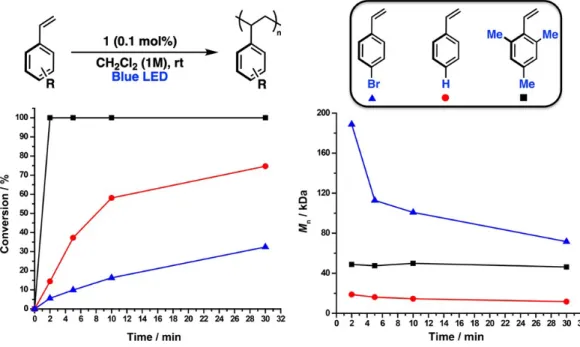
Conclusion
BIBLIOGRAPHY
Taming the cationic beast: new developments in the synthesis and application of weakly coordinating anions. Separating Electrophilicity and Lewis Acidity: The Synthesis, Characterization and Electrochemistry of the Electron Shortened Tris(aryl)boranes B(C6F5)3-n(C6Cl5)n (n = 1−3). Silver-free activation of ligated gold(I) chloride: The use of [Me3NB12Cl11] as a weakly coordinating anion in homogeneous gold catalysis.
Structure effects of Lewis acids on the living cationic polymerization of p-methoxystyrene: clear difference in polymerization behavior of vinyl ethers. Note: Initial investigations showed that the polymerizations occurred in the presence of atmospheric oxygen and radical scavengers (see ref. 11). Inhibition of S5 polymerization by 1 in the presence of 2,6-tBu2-C5H3N was also observed, indicating the importance of H+ in chain termination/reinitiation, which is common in uncontrolled carbocationic polymerizations.
Formation of styrene and α-methylstyrene radical cations upon irradiation of mixtures of these monomers with TiCl4 and SnCl4 in a semicrystalline heptane matrix. Polar interactions between clustered π-systems in 1,8-fluorinated diarylnaphthalene: Significance of quadrupole moments in molecular recognition. The effects of substituents on the sandwich configuration of multiply substituted benzene dimers are not driven solely by electrostatic control.
Effects of "Tilted-T" Edge-to-Face Aromatic Interactions on Conformational Selection and Solid-State Structure. Measurements of molecular electrostatic field effects in edge-to-face aromatic interactions and CH-π interactions with implications for protein folding and molecular recognition. New initiation systems based on added halide salts and the nature of the growing species.
